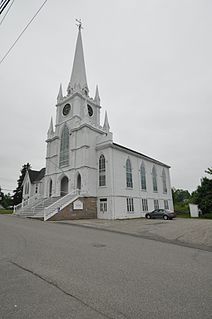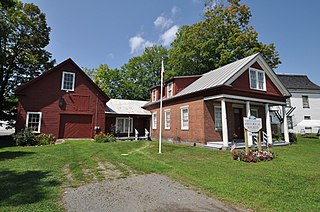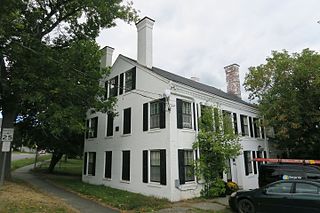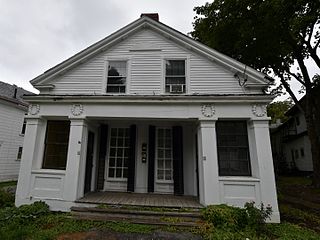
Hamilton Hall is a National Historic Landmark at 9 Chestnut Street in Salem, Massachusetts. Designed by noted Salem builder Samuel McIntire and built in 1805–07, it is an excellent instance of a public Federal style building. It was built as a social space for the leading families of Salem, and was named for Founding Father and Federalist Party leader Alexander Hamilton. It continues to function as a social hall today: it is used for events, private functions, weddings and is also home to a series of lectures that originated in 1944 by the Ladies Committee.

Centre Street Congregational Church is a historic church at 9 Center Street in Machias, Maine. Built in 1836-37, it is an important early example of Gothic Revival architecture in northern New England, apparently based on an early design by the noted Gothic architect Richard Upjohn. The building was listed on the National Register of Historic Places in 1975. The congregation is affiliated with the United Church of Christ; its current pastor is Rev. Susan Maxwell, M. Div.

The Elm Street Congregational Church and Parish House is a historic church complex at Elm and Franklin Streets in Bucksport, Maine. It includes a Greek Revival church building, built in 1838 to a design by Benjamin S. Deane, and an 1867 Second Empire parish house. The church congregation was founded in 1803; its present pastor is the Rev. Stephen York. The church and parish house were listed on the National Register of Historic Places in 1990. It is a congregational member of the United Church of Christ.
The First Baptist Church is a historic church building on High Street, off Maine State Route 172 in Sedgwick, Maine. It was designed in Greek Revival style by architect Benjamin S. Deane, based on published drawings by Asher Benjamin, and built in 1837 for a congregation founded in 1805. It is one of coastal Maine's finest Greek Revival churches, and was listed on the National Register of Historic Places in 1973.

Stetson Union Church, also known as the Stetson Meetinghouse, is a historic church building on Maine State Route 222 in Stetson, Maine. Built in 1843 to a design by Bangor architect Benjamin S. Deane, it is an excellent and well-preserved example of ecclesiastical Greek Revival architecture. The building was listed on the National Register of Historic Places in 1981. It is owned by the town.

The Former First Baptist Church is a historic church building at 37 Main Street in Skowhegan, Maine. Built in 1842-44, this Greek Revival brick building is one of the few works attributable to a local master builder, Joseph Bigelow. It was used as a church until 1919, after which it was used as a community center, and then a VFW hall until 2009. It is vacant, with plans to establish a performance and meeting venue; it was listed on the National Register of Historic Places in 1991.

The Jonas Cutting–Edward Kent House is a historic house at 48-50 Penobscot Street in Bangor, Maine. Built in 1836–37, it is one of the city's most unusual and elaborate examples of Greek Revival architecture. Built as a duplex, its first owners and occupants were Edward Kent, mayor and a future Governor of Maine, and his law partner, Jonas Cutting, a future Maine Supreme Judicial Court justice. The house was listed on the National Register of Historic Places in 1973.

The Gov. Abner Coburn House is a historic house on Main Street in Skowhegan, Maine. Built in 1849 by a local master builder, it is one of the town's finest examples of Greek Revival architecture. It was built for Skowhegan native Abner Coburn, one of its wealthiest citizens, who served one term as Governor of Maine. The house was listed on the National Register of Historic Places in 1974.

The Sophie May House is a historic house on Sophie May Lane in Norridgewock, Maine. Built in 1845, it is an excellent local example of Greek Revival architecture, with a classical four-columned Greek temple front. The house is most notable as the long-time home of Rebecca Sophia Clarke (1833-1906), who wrote a series of popular children's books under the pen name "Sophie May". The house was listed on the National Register of Historic Places in 1976.

The former Norridgewock Female Academy, now home to the Norridgewock Historical Society, is a historic school property on Mercer Road, just west of its junction with Upper Main Street in Norridgewock, Maine. Its Greek Revival building was built in 1837, when the school was founded, and was used by that institution until 1860. The building is regionally distinctive as one of a few surviving Greek Revival school buildings with a Greek temple portico. It was listed on the National Register of Historic Places in 1996.

The Wardwell-Trickey Double House is a historic two-family residence at 97-99 Ohio Street in Bangor, Maine. Built in 1836, it is one of the least-altered early duplex brick houses in the city, in a form that war rarely seen in the state outside Bangor. The house was listed on the National Register of Historic Places in 1992.

The Isaac Farrar Mansion, known for much of the 20th Century as Symphony House, is a historic house at 166 Union Street in Bangor, Maine. Built in 1833, it was the first major commission of the noted 19th-century architect Richard Upjohn. Although it was built as a private residence, it was from 1929 to 1972 owned by the Bangor Symphony Orchestra and was home to its music conservatory. It is now part of the Bangor YMCA. The house was listed on the National Register of Historic Places in 1972.

The Zebulon Smith House is a historic house at 55 Summer Street in Bangor, Maine. Built in 1832, it is one of the two oldest houses in the state of Maine to be built with a Greek Revival temple front. The house was listed on the National Register of Historic Places in 1974.

The Harper Family House is a historic house on Maine State Route 5 in Limerick, Maine. Estimated to date to 1809, it is one Limerick's few brick 19th-century houses, and possibly its oldest. It was owned by a single family for 144 years. The house was listed on the National Register of Historic Places in 1998.
The Temples Historic District encompasses a distinctive collection of Greek Revival houses on Madison Street in the rural village of North Anson, Maine. Built between about 1844 and 1858 were four houses in a row, three of which exhibit classical Greek temple-front facades, and assemblage that is unique in the rural interior of the state. The district was listed on the National Register of Historic Places in 1983.

The Thacher-Goodale House is a historic house at 121 North Street in Saco, Maine. Built in 1827, it is a sophisticated early expression of Greek Revival architecture, retaining significant Federal period details. Built for George Thacher, Jr., a lawyer, it was owned for many years by members of the Goodale family, most notably the botanist George Lincoln Goodale. The house was listed on the National Register of Historic Places in 1976.

The Thomas A. Hill House, also formerly known as the Grand Army Memorial Home, is a historic house at 159 Union Street in Bangor, Maine. Now housing the collections of the Bangor Historical Society and an American Civil War collection, the house was built in 1836 to a design by Richard Upjohn. The house has been home to two of Bangor's mayors, and became a museum in 1944. It was listed on the National Register of Historic Places in 1972.

The Charles G. Bryant Double House is a historic residential duplex at 16-18 Division Street in Bangor, Maine. Built in 1836 as a speculative venture by architect Charles G. Bryant, it has, unlike many similar local buildings of the period, retained most of its original Greek Revival styling. It was listed on the National Register of Historic Places in 1986.

The Huston House is a historic house at 220 Bristol Road in Damariscotta, Maine. Built in 1853, it is a rare statewide example of a large Greek Revival house with a longitudinal temple front. It now serves as home to the Down Easter Inn, and was listed on the National Register of Historic Places in 1985.

The Lot Morrill House is a historic house at 113 Winthrop Street in Augusta, Maine. Built about 1830, it is a fairly typical example of Greek Revival architecture, executed in brick. The house is notable as the home of United States Senator and Governor of Maine Lot Morrill during the period when he was at his height of power. It was listed on the National Register of Historic Places in 1974.



















